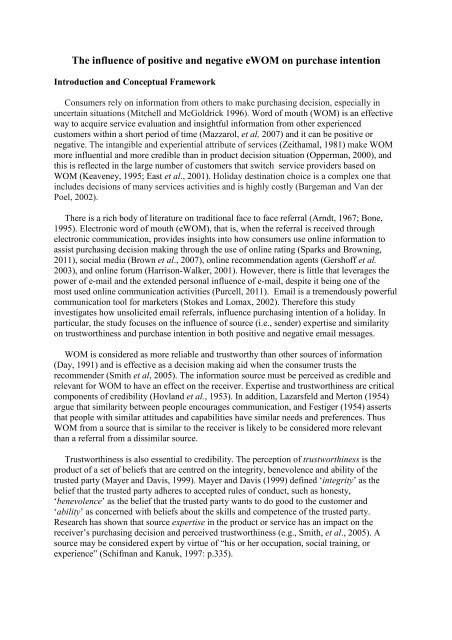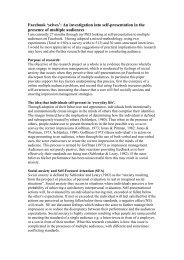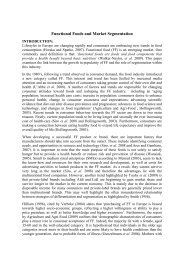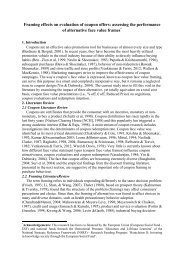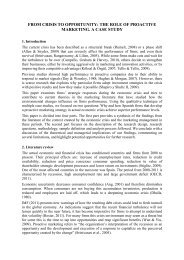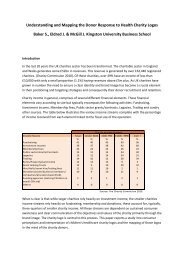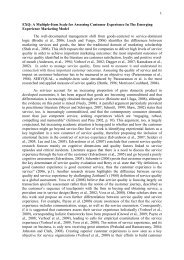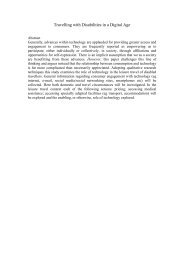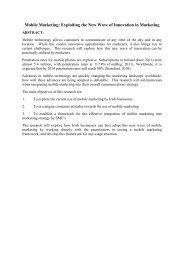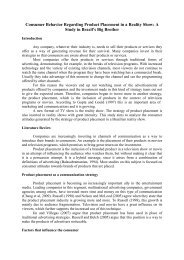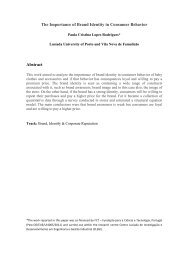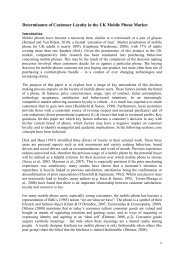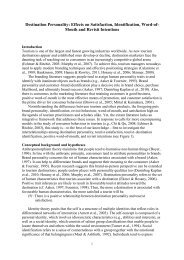The influence of positive and negative eWOM on purchase intention
The influence of positive and negative eWOM on purchase intention
The influence of positive and negative eWOM on purchase intention
Create successful ePaper yourself
Turn your PDF publications into a flip-book with our unique Google optimized e-Paper software.
<str<strong>on</strong>g>The</str<strong>on</strong>g> <str<strong>on</strong>g>influence</str<strong>on</strong>g> <str<strong>on</strong>g>of</str<strong>on</strong>g> <str<strong>on</strong>g>positive</str<strong>on</strong>g> <str<strong>on</strong>g>and</str<strong>on</strong>g> <str<strong>on</strong>g>negative</str<strong>on</strong>g> <str<strong>on</strong>g>eWOM</str<strong>on</strong>g> <strong>on</strong> <strong>purchase</strong> intenti<strong>on</strong><br />
Introducti<strong>on</strong> <str<strong>on</strong>g>and</str<strong>on</strong>g> C<strong>on</strong>ceptual Framework<br />
C<strong>on</strong>sumers rely <strong>on</strong> informati<strong>on</strong> from others to make purchasing decisi<strong>on</strong>, especially in<br />
uncertain situati<strong>on</strong>s (Mitchell <str<strong>on</strong>g>and</str<strong>on</strong>g> McGoldrick 1996). Word <str<strong>on</strong>g>of</str<strong>on</strong>g> mouth (WOM) is an effective<br />
way to acquire service evaluati<strong>on</strong> <str<strong>on</strong>g>and</str<strong>on</strong>g> insightful informati<strong>on</strong> from other experienced<br />
customers within a short period <str<strong>on</strong>g>of</str<strong>on</strong>g> time (Mazzarol, et al, 2007) <str<strong>on</strong>g>and</str<strong>on</strong>g> it can be <str<strong>on</strong>g>positive</str<strong>on</strong>g> or<br />
<str<strong>on</strong>g>negative</str<strong>on</strong>g>. <str<strong>on</strong>g>The</str<strong>on</strong>g> intangible <str<strong>on</strong>g>and</str<strong>on</strong>g> experiential attribute <str<strong>on</strong>g>of</str<strong>on</strong>g> services (Zeithamal, 1981) make WOM<br />
more influential <str<strong>on</strong>g>and</str<strong>on</strong>g> more credible than in product decisi<strong>on</strong> situati<strong>on</strong> (Opperman, 2000), <str<strong>on</strong>g>and</str<strong>on</strong>g><br />
this is reflected in the large number <str<strong>on</strong>g>of</str<strong>on</strong>g> customers that switch service providers based <strong>on</strong><br />
WOM (Keaveney, 1995; East et al., 2001). Holiday destinati<strong>on</strong> choice is a complex <strong>on</strong>e that<br />
includes decisi<strong>on</strong>s <str<strong>on</strong>g>of</str<strong>on</strong>g> many services activities <str<strong>on</strong>g>and</str<strong>on</strong>g> is highly costly (Bargeman <str<strong>on</strong>g>and</str<strong>on</strong>g> Van der<br />
Poel, 2002).<br />
<str<strong>on</strong>g>The</str<strong>on</strong>g>re is a rich body <str<strong>on</strong>g>of</str<strong>on</strong>g> literature <strong>on</strong> traditi<strong>on</strong>al face to face referral (Arndt, 1967; B<strong>on</strong>e,<br />
1995). Electr<strong>on</strong>ic word <str<strong>on</strong>g>of</str<strong>on</strong>g> mouth (<str<strong>on</strong>g>eWOM</str<strong>on</strong>g>), that is, when the referral is received through<br />
electr<strong>on</strong>ic communicati<strong>on</strong>, provides insights into how c<strong>on</strong>sumers use <strong>on</strong>line informati<strong>on</strong> to<br />
assist purchasing decisi<strong>on</strong> making through the use <str<strong>on</strong>g>of</str<strong>on</strong>g> <strong>on</strong>line rating (Sparks <str<strong>on</strong>g>and</str<strong>on</strong>g> Browning,<br />
2011), social media (Brown et al., 2007), <strong>on</strong>line recommendati<strong>on</strong> agents (Gersh<str<strong>on</strong>g>of</str<strong>on</strong>g>f et al.<br />
2003), <str<strong>on</strong>g>and</str<strong>on</strong>g> <strong>on</strong>line forum (Harris<strong>on</strong>-Walker, 2001). However, there is little that leverages the<br />
power <str<strong>on</strong>g>of</str<strong>on</strong>g> e-mail <str<strong>on</strong>g>and</str<strong>on</strong>g> the extended pers<strong>on</strong>al <str<strong>on</strong>g>influence</str<strong>on</strong>g> <str<strong>on</strong>g>of</str<strong>on</strong>g> e-mail, despite it being <strong>on</strong>e <str<strong>on</strong>g>of</str<strong>on</strong>g> the<br />
most used <strong>on</strong>line communicati<strong>on</strong> activities (Purcell, 2011). Email is a tremendously powerful<br />
communicati<strong>on</strong> tool for marketers (Stokes <str<strong>on</strong>g>and</str<strong>on</strong>g> Lomax, 2002). <str<strong>on</strong>g>The</str<strong>on</strong>g>refore this study<br />
investigates how unsolicited email referrals, <str<strong>on</strong>g>influence</str<strong>on</strong>g> purchasing intenti<strong>on</strong> <str<strong>on</strong>g>of</str<strong>on</strong>g> a holiday. In<br />
particular, the study focuses <strong>on</strong> the <str<strong>on</strong>g>influence</str<strong>on</strong>g> <str<strong>on</strong>g>of</str<strong>on</strong>g> source (i.e., sender) expertise <str<strong>on</strong>g>and</str<strong>on</strong>g> similarity<br />
<strong>on</strong> trustworthiness <str<strong>on</strong>g>and</str<strong>on</strong>g> <strong>purchase</strong> intenti<strong>on</strong> in both <str<strong>on</strong>g>positive</str<strong>on</strong>g> <str<strong>on</strong>g>and</str<strong>on</strong>g> <str<strong>on</strong>g>negative</str<strong>on</strong>g> email messages.<br />
WOM is c<strong>on</strong>sidered as more reliable <str<strong>on</strong>g>and</str<strong>on</strong>g> trustworthy than other sources <str<strong>on</strong>g>of</str<strong>on</strong>g> informati<strong>on</strong><br />
(Day, 1991) <str<strong>on</strong>g>and</str<strong>on</strong>g> is effective as a decisi<strong>on</strong> making aid when the c<strong>on</strong>sumer trusts the<br />
recommender (Smith et al, 2005). <str<strong>on</strong>g>The</str<strong>on</strong>g> informati<strong>on</strong> source must be perceived as credible <str<strong>on</strong>g>and</str<strong>on</strong>g><br />
relevant for WOM to have an effect <strong>on</strong> the receiver. Expertise <str<strong>on</strong>g>and</str<strong>on</strong>g> trustworthiness are critical<br />
comp<strong>on</strong>ents <str<strong>on</strong>g>of</str<strong>on</strong>g> credibility (Hovl<str<strong>on</strong>g>and</str<strong>on</strong>g> et al., 1953). In additi<strong>on</strong>, Lazarsfeld <str<strong>on</strong>g>and</str<strong>on</strong>g> Mert<strong>on</strong> (1954)<br />
argue that similarity between people encourages communicati<strong>on</strong>, <str<strong>on</strong>g>and</str<strong>on</strong>g> Festiger (1954) asserts<br />
that people with similar attitudes <str<strong>on</strong>g>and</str<strong>on</strong>g> capabilities have similar needs <str<strong>on</strong>g>and</str<strong>on</strong>g> preferences. Thus<br />
WOM from a source that is similar to the receiver is likely to be c<strong>on</strong>sidered more relevant<br />
than a referral from a dissimilar source.<br />
Trustworthiness is also essential to credibility. <str<strong>on</strong>g>The</str<strong>on</strong>g> percepti<strong>on</strong> <str<strong>on</strong>g>of</str<strong>on</strong>g> trustworthiness is the<br />
product <str<strong>on</strong>g>of</str<strong>on</strong>g> a set <str<strong>on</strong>g>of</str<strong>on</strong>g> beliefs that are centred <strong>on</strong> the integrity, benevolence <str<strong>on</strong>g>and</str<strong>on</strong>g> ability <str<strong>on</strong>g>of</str<strong>on</strong>g> the<br />
trusted party (Mayer <str<strong>on</strong>g>and</str<strong>on</strong>g> Davis, 1999). Mayer <str<strong>on</strong>g>and</str<strong>on</strong>g> Davis (1999) defined ‘integrity’ as the<br />
belief that the trusted party adheres to accepted rules <str<strong>on</strong>g>of</str<strong>on</strong>g> c<strong>on</strong>duct, such as h<strong>on</strong>esty,<br />
‘benevolence’ as the belief that the trusted party wants to do good to the customer <str<strong>on</strong>g>and</str<strong>on</strong>g><br />
‘ability’ as c<strong>on</strong>cerned with beliefs about the skills <str<strong>on</strong>g>and</str<strong>on</strong>g> competence <str<strong>on</strong>g>of</str<strong>on</strong>g> the trusted party.<br />
Research has shown that source expertise in the product or service has an impact <strong>on</strong> the<br />
receiver’s purchasing decisi<strong>on</strong> <str<strong>on</strong>g>and</str<strong>on</strong>g> perceived trustworthiness (e.g., Smith, et al., 2005). A<br />
source may be c<strong>on</strong>sidered expert by virtue <str<strong>on</strong>g>of</str<strong>on</strong>g> “his or her occupati<strong>on</strong>, social training, or<br />
experience” (Schifman <str<strong>on</strong>g>and</str<strong>on</strong>g> Kanuk, 1997: p.335).
Online c<strong>on</strong>sumers are used to relying <strong>on</strong> other c<strong>on</strong>sumers’ product/service ratings to make<br />
their purchasing decisi<strong>on</strong> (Sparks <str<strong>on</strong>g>and</str<strong>on</strong>g> Browning, 2011). In the specific c<strong>on</strong>text <str<strong>on</strong>g>of</str<strong>on</strong>g> this study,<br />
the travel industry, people who are frequent travellers accumulate knowledge <str<strong>on</strong>g>and</str<strong>on</strong>g> retain<br />
expertise from their experiences (Kerstetter <str<strong>on</strong>g>and</str<strong>on</strong>g> Cho, 2004). <str<strong>on</strong>g>The</str<strong>on</strong>g>se characteristics may permit<br />
c<strong>on</strong>sumers to effect others’ choices with respect to destinati<strong>on</strong> related alternatives (Kerstetter<br />
<str<strong>on</strong>g>and</str<strong>on</strong>g> Cho, 2004). <str<strong>on</strong>g>The</str<strong>on</strong>g>refore we incorporated sender expertise into our scenario <str<strong>on</strong>g>and</str<strong>on</strong>g><br />
hypothesise:<br />
H1: <str<strong>on</strong>g>The</str<strong>on</strong>g> greater the perceived expertise <str<strong>on</strong>g>of</str<strong>on</strong>g> the source, the greater their perceived<br />
trustworthiness.<br />
C<strong>on</strong>sumers appear to give more weight to recommendati<strong>on</strong>s coming from those with<br />
greater knowledge about products <str<strong>on</strong>g>and</str<strong>on</strong>g> services. C<strong>on</strong>sequently, informati<strong>on</strong> from an expert<br />
source is also more influential (Bansaal <str<strong>on</strong>g>and</str<strong>on</strong>g> Voyer, 2000). <str<strong>on</strong>g>The</str<strong>on</strong>g>refore we hypothesise that:<br />
H2: <str<strong>on</strong>g>The</str<strong>on</strong>g> greater the perceived expertise <str<strong>on</strong>g>of</str<strong>on</strong>g> the source, the greater their perceived <str<strong>on</strong>g>influence</str<strong>on</strong>g> <strong>on</strong><br />
<strong>purchase</strong> intenti<strong>on</strong>.<br />
Similarity is the degree to which individuals are similar in terms <str<strong>on</strong>g>of</str<strong>on</strong>g> certain attributes<br />
including demographic <str<strong>on</strong>g>and</str<strong>on</strong>g> lifestyle (Wangenheim <str<strong>on</strong>g>and</str<strong>on</strong>g> Bay<strong>on</strong>, 2003) <str<strong>on</strong>g>and</str<strong>on</strong>g> perceptual believes<br />
<str<strong>on</strong>g>and</str<strong>on</strong>g> values (Gilly, et al., 1998). Similarity between people facilitates the development <str<strong>on</strong>g>of</str<strong>on</strong>g> close<br />
relati<strong>on</strong>ships <str<strong>on</strong>g>and</str<strong>on</strong>g> friendships (Lazarsfeld <str<strong>on</strong>g>and</str<strong>on</strong>g> Mert<strong>on</strong>, 1954), as individuals tend to affiliate<br />
with others who share similar interests or are in a similar situati<strong>on</strong> (Schacter, 1959). Similarity<br />
predisposes people towards a greater level <str<strong>on</strong>g>of</str<strong>on</strong>g> interpers<strong>on</strong>al attracti<strong>on</strong>, trust <str<strong>on</strong>g>and</str<strong>on</strong>g> underst<str<strong>on</strong>g>and</str<strong>on</strong>g>ing<br />
than would be expected am<strong>on</strong>g dissimilar individuals (Ruef et al., 2003). Thus we<br />
hypothesise:<br />
H3: <str<strong>on</strong>g>The</str<strong>on</strong>g> greater the perceived similarity <str<strong>on</strong>g>of</str<strong>on</strong>g> the source, the greater their perceived<br />
trustworthiness.<br />
Similarity facilitates the flow <str<strong>on</strong>g>of</str<strong>on</strong>g> product informati<strong>on</strong> due to a percepti<strong>on</strong> <str<strong>on</strong>g>of</str<strong>on</strong>g> ease associated<br />
with the communicati<strong>on</strong> (Price <str<strong>on</strong>g>and</str<strong>on</strong>g> Feik, 1984). People with similar attributes, such as age,<br />
gender, educati<strong>on</strong> or lifestyle are likely to have similar values <str<strong>on</strong>g>and</str<strong>on</strong>g> needs. C<strong>on</strong>sequently,<br />
WOM regarding product/service informati<strong>on</strong> from such source is perceived as more relevant<br />
<str<strong>on</strong>g>and</str<strong>on</strong>g> will exert more <str<strong>on</strong>g>influence</str<strong>on</strong>g> (Gilly et al., 1998). Thus we hypothesise:<br />
H4: <str<strong>on</strong>g>The</str<strong>on</strong>g> greater the perceived similarity <str<strong>on</strong>g>of</str<strong>on</strong>g> the source, the greater their perceived <str<strong>on</strong>g>influence</str<strong>on</strong>g><br />
<strong>on</strong> <strong>purchase</strong> intenti<strong>on</strong>.<br />
When a message recipient is c<strong>on</strong>fident that an expert source will be willing to provide<br />
accurate informati<strong>on</strong> because <str<strong>on</strong>g>of</str<strong>on</strong>g> his or her high trustworthiness, they may forgo the effortful<br />
task <str<strong>on</strong>g>of</str<strong>on</strong>g> scrutinizing the message <str<strong>on</strong>g>and</str<strong>on</strong>g> instead unthinkingly accept the source’s c<strong>on</strong>clusi<strong>on</strong> as<br />
valid. Informati<strong>on</strong> presented by trustworthy sources is, as such, more likely to be unthinkingly<br />
accepted (Priester <str<strong>on</strong>g>and</str<strong>on</strong>g> Petty, 1995). <str<strong>on</strong>g>The</str<strong>on</strong>g>refore we hypothesise that:<br />
H5: <str<strong>on</strong>g>The</str<strong>on</strong>g> greater the perceived trustworthiness <str<strong>on</strong>g>of</str<strong>on</strong>g> the source, the greater its <str<strong>on</strong>g>influence</str<strong>on</strong>g> <strong>on</strong><br />
purchasing intenti<strong>on</strong>.<br />
WOM can be <str<strong>on</strong>g>positive</str<strong>on</strong>g> or <str<strong>on</strong>g>negative</str<strong>on</strong>g>. Positive WOM (pWOM) refers to favourable<br />
experiences <str<strong>on</strong>g>and</str<strong>on</strong>g> recommendati<strong>on</strong>s to buy, <str<strong>on</strong>g>negative</str<strong>on</strong>g> WOM (nWOM) to unfavourable<br />
experiences <str<strong>on</strong>g>and</str<strong>on</strong>g> recommendati<strong>on</strong>s not to buy (Luo, 2009). Investigati<strong>on</strong> <str<strong>on</strong>g>of</str<strong>on</strong>g> the differences in<br />
the impact <str<strong>on</strong>g>of</str<strong>on</strong>g> nWOM <str<strong>on</strong>g>and</str<strong>on</strong>g> pWOM <strong>on</strong>line has been increasing. Nevertheless, most <str<strong>on</strong>g>of</str<strong>on</strong>g> these<br />
studies focus <strong>on</strong> product/br<str<strong>on</strong>g>and</str<strong>on</strong>g> choices rather than services. Studies <strong>on</strong> <str<strong>on</strong>g>eWOM</str<strong>on</strong>g> are generally<br />
c<strong>on</strong>sistent with the negativity bias theory (Folkes <str<strong>on</strong>g>and</str<strong>on</strong>g> Kamins, 1999); <str<strong>on</strong>g>negative</str<strong>on</strong>g> <str<strong>on</strong>g>eWOM</str<strong>on</strong>g> has a<br />
significantly higher impact <strong>on</strong> c<strong>on</strong>sumers’ evaluati<strong>on</strong> <str<strong>on</strong>g>of</str<strong>on</strong>g> their emoti<strong>on</strong>al trust <str<strong>on</strong>g>and</str<strong>on</strong>g> intenti<strong>on</strong> to
shop <strong>on</strong>line (Cheung <str<strong>on</strong>g>and</str<strong>on</strong>g> Lee, 2008). In additi<strong>on</strong>, <str<strong>on</strong>g>negative</str<strong>on</strong>g> opini<strong>on</strong>s receive more<br />
c<strong>on</strong>siderati<strong>on</strong> by recipients than <str<strong>on</strong>g>positive</str<strong>on</strong>g> opini<strong>on</strong> (Sparks <str<strong>on</strong>g>and</str<strong>on</strong>g> Browning, 2011). This may be<br />
because <str<strong>on</strong>g>negative</str<strong>on</strong>g> opini<strong>on</strong>s are perceived as more credible <str<strong>on</strong>g>and</str<strong>on</strong>g> easier to generalise than<br />
<str<strong>on</strong>g>positive</str<strong>on</strong>g> opini<strong>on</strong>s (Mizerski, 1982). Chatterjee (2001), however, disagrees with this noti<strong>on</strong> as<br />
the credibility <str<strong>on</strong>g>of</str<strong>on</strong>g> an <strong>on</strong>line source is minimal when compared with face to face<br />
communicati<strong>on</strong>. In c<strong>on</strong>trast to other studies, Ahluwalia, (2002) <str<strong>on</strong>g>and</str<strong>on</strong>g> East et al. (2008) found<br />
that <str<strong>on</strong>g>positive</str<strong>on</strong>g> informati<strong>on</strong> has a str<strong>on</strong>ger impact <strong>on</strong> br<str<strong>on</strong>g>and</str<strong>on</strong>g> choice than <str<strong>on</strong>g>negative</str<strong>on</strong>g> informati<strong>on</strong>.<br />
C<strong>on</strong>sequently, we hypothesise that:<br />
H6: <str<strong>on</strong>g>The</str<strong>on</strong>g> impact <str<strong>on</strong>g>of</str<strong>on</strong>g> source characteristics <str<strong>on</strong>g>and</str<strong>on</strong>g> trustworthiness <strong>on</strong> <strong>purchase</strong> intenti<strong>on</strong> will differ<br />
according to email message directi<strong>on</strong> (i.e., <str<strong>on</strong>g>positive</str<strong>on</strong>g> versus <str<strong>on</strong>g>negative</str<strong>on</strong>g> <str<strong>on</strong>g>eWOM</str<strong>on</strong>g>).<br />
Research Design<br />
A 2 (<str<strong>on</strong>g>positive</str<strong>on</strong>g>/<str<strong>on</strong>g>negative</str<strong>on</strong>g>) x 2 (expert/n<strong>on</strong>-expert) x 2 (similar/n<strong>on</strong>-similar), full factorial,<br />
between subjects survey research design, using unsolicited e-mail scenarios, was used to<br />
test the hypotheses. Two extreme scenarios – <str<strong>on</strong>g>positive</str<strong>on</strong>g>, expert, similar <str<strong>on</strong>g>and</str<strong>on</strong>g>, <str<strong>on</strong>g>negative</str<strong>on</strong>g>, n<strong>on</strong>expert,<br />
dissimilar – are shown in Figure 1. As the study focuses <strong>on</strong> the relati<strong>on</strong>ships<br />
between source characteristics <str<strong>on</strong>g>and</str<strong>on</strong>g> individual factors as they impact <strong>on</strong> behavioural<br />
intenti<strong>on</strong>s, the sample needed to be (i) homogeneous <str<strong>on</strong>g>and</str<strong>on</strong>g> (ii) comfortable receiving<br />
<str<strong>on</strong>g>eWOM</str<strong>on</strong>g>. Undergraduate students are homogenous in terms <str<strong>on</strong>g>of</str<strong>on</strong>g> age, interest <str<strong>on</strong>g>and</str<strong>on</strong>g> use <str<strong>on</strong>g>of</str<strong>on</strong>g><br />
computers <str<strong>on</strong>g>and</str<strong>on</strong>g> extensively use email, fulfilling both criteria. <str<strong>on</strong>g>The</str<strong>on</strong>g> survey was distributed<br />
<str<strong>on</strong>g>and</str<strong>on</strong>g> administered during lectures, with an equal number <str<strong>on</strong>g>of</str<strong>on</strong>g> each scenario distributed. In<br />
total, 650 questi<strong>on</strong>naires were returned. One hundred <str<strong>on</strong>g>and</str<strong>on</strong>g> seventy seven questi<strong>on</strong>naires<br />
were discarded due to missing resp<strong>on</strong>ses.<br />
Figure 1: Scenarios<br />
Scenario: Positive/ Expert/ Similar<br />
You have received the following e-mail from your friend, who is similar to you. She/he travels abroad a lot<br />
to different destinati<strong>on</strong>s <str<strong>on</strong>g>and</str<strong>on</strong>g> is telling you about her/his holiday. Please read the e-mail <str<strong>on</strong>g>and</str<strong>on</strong>g> complete the<br />
questi<strong>on</strong>naire.<br />
Hey sorry I wasn’t in-touch last week. I have been to yet another place for a holiday <str<strong>on</strong>g>and</str<strong>on</strong>g> have just got back<br />
home. That holiday was good value. It was really fantastic. I should have g<strong>on</strong>e there so<strong>on</strong>er. You should have<br />
seen the beaches, really gorgeous, the place was fabulous, great weather, never been to such a brilliant place;<br />
wow, I might even go back there again you’d love it.<br />
Got to go, time to go out<br />
See you around<br />
Scenario: Negative/ N<strong>on</strong>-expert/ Dissimilar<br />
You have received the following e-mail from your friend, who is not similar to you. She/he has never<br />
travelled abroad before <str<strong>on</strong>g>and</str<strong>on</strong>g> is telling you about her/his holiday. Please read the e-mail <str<strong>on</strong>g>and</str<strong>on</strong>g> complete the<br />
questi<strong>on</strong>naire.<br />
Hi, sorry I have not been in-touch for a while. I have changed where I go to <strong>on</strong> my annual holiday <str<strong>on</strong>g>and</str<strong>on</strong>g> have<br />
just got back home. That holiday was not good value. It was really awful. I should not have g<strong>on</strong>e there. You<br />
should have seen the beaches, really like a rubbish dump. <str<strong>on</strong>g>The</str<strong>on</strong>g> place was horrible, lousy weather. It is such a<br />
boring place. It is not somewhere I’d go back to, definitely not worth visiting.<br />
Look forward to seeing you when we have the chance<br />
Catch up with you later<br />
Expertise was measured using a five-item, seven point semantic differential scale<br />
(Netemeyer <str<strong>on</strong>g>and</str<strong>on</strong>g> Bearden, 1992; Bansal <str<strong>on</strong>g>and</str<strong>on</strong>g> Voyer, 2000). <str<strong>on</strong>g>The</str<strong>on</strong>g> scale used to measure<br />
similarity (Brown <str<strong>on</strong>g>and</str<strong>on</strong>g> Reingen, 1987; Gilly, et al., 1998) c<strong>on</strong>tained five items with resp<strong>on</strong>ses<br />
ranging from not similar at all to very similar. Trustworthiness c<strong>on</strong>sisted <str<strong>on</strong>g>of</str<strong>on</strong>g> three factors -<br />
Ability, Benevolence, <str<strong>on</strong>g>and</str<strong>on</strong>g> Integrity (Mayer et al., 1995) – <str<strong>on</strong>g>and</str<strong>on</strong>g> was measured using seventeen<br />
seven point Likert items: six for ability, five for benevolence <str<strong>on</strong>g>and</str<strong>on</strong>g> six for integrity. Purchase
intenti<strong>on</strong> was measured using five semantic differential items with seven resp<strong>on</strong>se categories<br />
(Brunner <str<strong>on</strong>g>and</str<strong>on</strong>g> Hensel, 1996).<br />
Analysis<br />
Refining the measurement model statistics resulted in deleting <strong>on</strong>e item from the integrity<br />
measure. <str<strong>on</strong>g>The</str<strong>on</strong>g> overall model fit statistics for the measurement model including all the<br />
c<strong>on</strong>structs was acceptable:<br />
Figure 2: Positive <str<strong>on</strong>g>and</str<strong>on</strong>g> Negative <str<strong>on</strong>g>eWOM</str<strong>on</strong>g> models<br />
CMIN (724) = 1325.472, p<br />
=.000, CMIN/DF = 1.831,<br />
TLI = .917, CFI = .926,<br />
RMSEA = .042. Metric<br />
invariance was also<br />
established across the<br />
<str<strong>on</strong>g>positive</str<strong>on</strong>g>/ <str<strong>on</strong>g>negative</str<strong>on</strong>g> scenarios.<br />
AVEs were generally<br />
acceptable (i.e., greater than<br />
.5), though some <str<strong>on</strong>g>of</str<strong>on</strong>g> the subdimensi<strong>on</strong>s<br />
<str<strong>on</strong>g>of</str<strong>on</strong>g> trustworthiness<br />
were marginal: benevolence =<br />
.49 (<str<strong>on</strong>g>negative</str<strong>on</strong>g> model), .48<br />
(<str<strong>on</strong>g>positive</str<strong>on</strong>g> model); integrity =<br />
.42 (<str<strong>on</strong>g>negative</str<strong>on</strong>g> model). All the<br />
CRs were above .7 except those associated with the lower than desired AVEs. <str<strong>on</strong>g>The</str<strong>on</strong>g><br />
discriminant validity <str<strong>on</strong>g>of</str<strong>on</strong>g> the<br />
trustworthiness sub-dimensi<strong>on</strong>s<br />
was c<strong>on</strong>firmed by the three factor<br />
model being a significantly better<br />
fit <str<strong>on</strong>g>of</str<strong>on</strong>g> the data than a single factor<br />
model (Hair et al., 2010).<br />
<str<strong>on</strong>g>The</str<strong>on</strong>g> structural models were<br />
fitted simultaneously. <str<strong>on</strong>g>The</str<strong>on</strong>g> model<br />
fit statistics were acceptable:<br />
CMIN (749) = 1353.142, p =.000,<br />
CMIN/DF = 1.807, TLI = .919,<br />
CFI = .926, RMSEA = .041. When<br />
the relati<strong>on</strong>ships between<br />
c<strong>on</strong>structs were c<strong>on</strong>strained to be<br />
equal across <str<strong>on</strong>g>negative</str<strong>on</strong>g> <str<strong>on</strong>g>and</str<strong>on</strong>g> <str<strong>on</strong>g>positive</str<strong>on</strong>g><br />
<str<strong>on</strong>g>eWOM</str<strong>on</strong>g> models there was a<br />
significant differences between the<br />
two models (∆χ² (13) = 32.037,<br />
Table 1: Structural Paths Estimates<br />
Paths Path estimates<br />
From To Both Positive Negative<br />
Expertise Ability .333<br />
Expertise Integrity .286<br />
Similarity Ability .228<br />
Similarity Integrity .219<br />
Benevolence Ability .580<br />
Integrity Benevolence .866<br />
Benevolence Purchase .367<br />
Expertise Purchase .242<br />
Similarity Purchase .791 .382<br />
In all cases p < .001<br />
Table 2: Direct <str<strong>on</strong>g>and</str<strong>on</strong>g> indirect effects<br />
Model Direct Indirect Total<br />
Positive <str<strong>on</strong>g>eWOM</str<strong>on</strong>g> .242 --- ..242<br />
Expertise Negative <str<strong>on</strong>g>eWOM</str<strong>on</strong>g> .242 .090 .332<br />
Positive <str<strong>on</strong>g>eWOM</str<strong>on</strong>g> .791 --- .791<br />
Similarity Negative <str<strong>on</strong>g>eWOM</str<strong>on</strong>g> .382 .070 .452<br />
p=.002), indicating differences between the <str<strong>on</strong>g>positive</str<strong>on</strong>g> <str<strong>on</strong>g>and</str<strong>on</strong>g> <str<strong>on</strong>g>negative</str<strong>on</strong>g> message scenarios. Each<br />
path was then individually c<strong>on</strong>strained to identify where the differences between the <str<strong>on</strong>g>positive</str<strong>on</strong>g><br />
<str<strong>on</strong>g>and</str<strong>on</strong>g> <str<strong>on</strong>g>negative</str<strong>on</strong>g> models occurred. Three paths differed: from Similarity to Ability, from<br />
Similarity to Purchase Intenti<strong>on</strong>, <str<strong>on</strong>g>and</str<strong>on</strong>g> from Benevolence to Purchase Intenti<strong>on</strong>. <str<strong>on</strong>g>The</str<strong>on</strong>g> resulting<br />
models are shown in Figure 2, Table 1 shows the regressi<strong>on</strong> weights <str<strong>on</strong>g>and</str<strong>on</strong>g> the effects <str<strong>on</strong>g>of</str<strong>on</strong>g> source<br />
characteristics <strong>on</strong> <strong>purchase</strong> intenti<strong>on</strong>s are in Table 2.
Findings <str<strong>on</strong>g>and</str<strong>on</strong>g> C<strong>on</strong>clusi<strong>on</strong>s<br />
This paper determined the impact <str<strong>on</strong>g>of</str<strong>on</strong>g> source expertise <str<strong>on</strong>g>and</str<strong>on</strong>g> similarity <strong>on</strong> <strong>purchase</strong> intenti<strong>on</strong>.<br />
In particular, it examined whether source expertise <str<strong>on</strong>g>and</str<strong>on</strong>g> similarity impacted directly or through<br />
trustworthiness, <str<strong>on</strong>g>and</str<strong>on</strong>g> whether their impact differed according to message directi<strong>on</strong> (i.e.,<br />
<str<strong>on</strong>g>positive</str<strong>on</strong>g> or <str<strong>on</strong>g>negative</str<strong>on</strong>g>). <str<strong>on</strong>g>The</str<strong>on</strong>g> analysis clearly showed that both expertise <str<strong>on</strong>g>and</str<strong>on</strong>g> similarity impacted<br />
directly <strong>on</strong> <strong>purchase</strong> intenti<strong>on</strong>. However, there was little indirect impact <strong>on</strong> <strong>purchase</strong> intenti<strong>on</strong><br />
through trustworthiness. While, with <str<strong>on</strong>g>negative</str<strong>on</strong>g> <str<strong>on</strong>g>eWOM</str<strong>on</strong>g>, expertise <str<strong>on</strong>g>and</str<strong>on</strong>g> similarity acted directly<br />
<strong>on</strong> <strong>purchase</strong> intenti<strong>on</strong>, but also through trustworthiness, with <str<strong>on</strong>g>positive</str<strong>on</strong>g> <str<strong>on</strong>g>eWOM</str<strong>on</strong>g> <strong>on</strong>ly a direct<br />
effect was observed. However, despite the lack <str<strong>on</strong>g>of</str<strong>on</strong>g> any indirect effects, the impact <str<strong>on</strong>g>of</str<strong>on</strong>g> source<br />
similarity <strong>on</strong> <strong>purchase</strong> intenti<strong>on</strong> was significantly greater with <str<strong>on</strong>g>positive</str<strong>on</strong>g> <str<strong>on</strong>g>eWOM</str<strong>on</strong>g>.<br />
Table 3 summarises the hypotheses. <str<strong>on</strong>g>The</str<strong>on</strong>g> study’s findings support the hypotheses<br />
c<strong>on</strong>cerning the direct effect <str<strong>on</strong>g>of</str<strong>on</strong>g> source expertise <str<strong>on</strong>g>and</str<strong>on</strong>g> similarity <strong>on</strong> <strong>purchase</strong> intenti<strong>on</strong>s (H2 <str<strong>on</strong>g>and</str<strong>on</strong>g><br />
H4), as well as showing that there are differences between <str<strong>on</strong>g>positive</str<strong>on</strong>g> <str<strong>on</strong>g>and</str<strong>on</strong>g> <str<strong>on</strong>g>negative</str<strong>on</strong>g> <str<strong>on</strong>g>eWOM</str<strong>on</strong>g> (H6).<br />
<str<strong>on</strong>g>The</str<strong>on</strong>g> effect <str<strong>on</strong>g>of</str<strong>on</strong>g> source characteristics <strong>on</strong> trustworthiness (H1 <str<strong>on</strong>g>and</str<strong>on</strong>g> H3) is, however, <strong>on</strong>ly partially<br />
support as the percepti<strong>on</strong> <str<strong>on</strong>g>of</str<strong>on</strong>g> benevolence is not <str<strong>on</strong>g>influence</str<strong>on</strong>g>d by either expertise or similarity,<br />
<str<strong>on</strong>g>and</str<strong>on</strong>g> it is <strong>on</strong>ly with <str<strong>on</strong>g>negative</str<strong>on</strong>g> <str<strong>on</strong>g>eWOM</str<strong>on</strong>g> that similarity <str<strong>on</strong>g>influence</str<strong>on</strong>g>s the assessment <str<strong>on</strong>g>of</str<strong>on</strong>g> integrity. H5<br />
was largely unsupported as it was <strong>on</strong>ly with the <str<strong>on</strong>g>negative</str<strong>on</strong>g> model that a relati<strong>on</strong>ship is observed<br />
between any <str<strong>on</strong>g>of</str<strong>on</strong>g> the trustworthiness sub-dimensi<strong>on</strong>s (specifically benevolence) <str<strong>on</strong>g>and</str<strong>on</strong>g> <strong>purchase</strong><br />
intenti<strong>on</strong>.<br />
Table 3: Summary <str<strong>on</strong>g>of</str<strong>on</strong>g> Hypotheses<br />
Hypothesis<br />
<str<strong>on</strong>g>The</str<strong>on</strong>g> greater the perceived expertise <str<strong>on</strong>g>of</str<strong>on</strong>g> the source, the greater their perceived<br />
H1<br />
trustworthiness<br />
<str<strong>on</strong>g>The</str<strong>on</strong>g> greater the perceived expertise <str<strong>on</strong>g>of</str<strong>on</strong>g> the source, the greater their perceived<br />
H2<br />
<str<strong>on</strong>g>influence</str<strong>on</strong>g> <strong>on</strong> <strong>purchase</strong> intenti<strong>on</strong><br />
<str<strong>on</strong>g>The</str<strong>on</strong>g> greater the perceived similarity <str<strong>on</strong>g>of</str<strong>on</strong>g> the source, the greater their perceived<br />
H3<br />
trustworthiness<br />
<str<strong>on</strong>g>The</str<strong>on</strong>g> greater the perceived similarity <str<strong>on</strong>g>of</str<strong>on</strong>g> the source, the greater their perceived<br />
H4<br />
<str<strong>on</strong>g>influence</str<strong>on</strong>g> <strong>on</strong> <strong>purchase</strong> intenti<strong>on</strong><br />
<str<strong>on</strong>g>The</str<strong>on</strong>g> greater the perceived trustworthiness <str<strong>on</strong>g>of</str<strong>on</strong>g> the source, the greater its <str<strong>on</strong>g>influence</str<strong>on</strong>g><br />
H5<br />
<strong>on</strong> purchasing intenti<strong>on</strong><br />
<str<strong>on</strong>g>The</str<strong>on</strong>g> impact <str<strong>on</strong>g>of</str<strong>on</strong>g> source characteristics <str<strong>on</strong>g>and</str<strong>on</strong>g> trustworthiness <strong>on</strong> <strong>purchase</strong> intenti<strong>on</strong><br />
H6 will differ according to email message directi<strong>on</strong> (i.e., <str<strong>on</strong>g>positive</str<strong>on</strong>g> versus <str<strong>on</strong>g>negative</str<strong>on</strong>g><br />
<str<strong>on</strong>g>eWOM</str<strong>on</strong>g>)<br />
Partially<br />
supported<br />
Supported<br />
Partially<br />
supported<br />
Supported<br />
Largely<br />
unsupported<br />
Supported<br />
<str<strong>on</strong>g>The</str<strong>on</strong>g> relati<strong>on</strong>ships between source characteristics <str<strong>on</strong>g>and</str<strong>on</strong>g> trustworthiness are largely irrelevant<br />
to <str<strong>on</strong>g>eWOM</str<strong>on</strong>g> as <strong>on</strong>ly benevolence is important to <strong>purchase</strong> intenti<strong>on</strong> <str<strong>on</strong>g>and</str<strong>on</strong>g> this <strong>on</strong>ly occurs with<br />
<str<strong>on</strong>g>negative</str<strong>on</strong>g> messages. In c<strong>on</strong>trast, the evidence for the direct effects <str<strong>on</strong>g>of</str<strong>on</strong>g> expertise <str<strong>on</strong>g>and</str<strong>on</strong>g> similarity<br />
<strong>on</strong> <strong>purchase</strong> intenti<strong>on</strong> is much str<strong>on</strong>ger. In most cases these relati<strong>on</strong>ships are equivalent across<br />
<str<strong>on</strong>g>negative</str<strong>on</strong>g> <str<strong>on</strong>g>and</str<strong>on</strong>g> <str<strong>on</strong>g>positive</str<strong>on</strong>g> messages, however, similarity has a greater direct impact <strong>on</strong> <strong>purchase</strong><br />
intenti<strong>on</strong> with <str<strong>on</strong>g>positive</str<strong>on</strong>g> messages. Differences in attributi<strong>on</strong> across <str<strong>on</strong>g>negative</str<strong>on</strong>g> <str<strong>on</strong>g>and</str<strong>on</strong>g> <str<strong>on</strong>g>positive</str<strong>on</strong>g><br />
messages might explain this. When <str<strong>on</strong>g>negative</str<strong>on</strong>g> experiences are reported attributi<strong>on</strong> might be<br />
being assigned to the source (i.e., they did something wr<strong>on</strong>g), whereas with <str<strong>on</strong>g>positive</str<strong>on</strong>g><br />
experiences attributi<strong>on</strong> could be being assigned to the situati<strong>on</strong> (i.e., the holiday destinati<strong>on</strong>).<br />
Overall, these findings indicate that similarity has a str<strong>on</strong>ger impact <strong>on</strong> <strong>purchase</strong> intenti<strong>on</strong><br />
than expertise. <str<strong>on</strong>g>The</str<strong>on</strong>g> impact <str<strong>on</strong>g>of</str<strong>on</strong>g> similarity <strong>on</strong> <strong>purchase</strong> intenti<strong>on</strong> is clearly str<strong>on</strong>ger with <str<strong>on</strong>g>positive</str<strong>on</strong>g><br />
messages, whereas the additi<strong>on</strong> <str<strong>on</strong>g>of</str<strong>on</strong>g> indirect effects makes the impact <str<strong>on</strong>g>of</str<strong>on</strong>g> expertise <strong>on</strong> <strong>purchase</strong><br />
intenti<strong>on</strong> slight str<strong>on</strong>ger with <str<strong>on</strong>g>negative</str<strong>on</strong>g> messages.
References:<br />
Ahluwalia, R. (2002), “How prevalent is the negativity effect in c<strong>on</strong>sumer envir<strong>on</strong>ments?”<br />
Journal <str<strong>on</strong>g>of</str<strong>on</strong>g> C<strong>on</strong>sumer Research, Vol. 29, No. 2, 270-279.<br />
Arndt, J. (1967), “Role <str<strong>on</strong>g>of</str<strong>on</strong>g> product related c<strong>on</strong>versati<strong>on</strong> in the diffusi<strong>on</strong> <str<strong>on</strong>g>of</str<strong>on</strong>g> a new product,”<br />
Journal <str<strong>on</strong>g>of</str<strong>on</strong>g> Marketing Research, Vol. 4, No. 3, 291-295.<br />
Bansal, H. S., <str<strong>on</strong>g>and</str<strong>on</strong>g> Voyer, P. A. (2000), “Word <str<strong>on</strong>g>of</str<strong>on</strong>g> mouth processes within a services <strong>purchase</strong><br />
decisi<strong>on</strong> c<strong>on</strong>text”, Journal <str<strong>on</strong>g>of</str<strong>on</strong>g> Services Research, Vol. 3, No. 2, 166-177.<br />
Bargeman, B., <str<strong>on</strong>g>and</str<strong>on</strong>g> van der Poel, H. (2006), “<str<strong>on</strong>g>The</str<strong>on</strong>g> role <str<strong>on</strong>g>of</str<strong>on</strong>g> routines in the vacati<strong>on</strong> decisi<strong>on</strong>making<br />
process <str<strong>on</strong>g>of</str<strong>on</strong>g> Dutch vacati<strong>on</strong>ers”, Tourism Management, Vol. 27, No. 4, 707-720.<br />
Bickart, B., <str<strong>on</strong>g>and</str<strong>on</strong>g> Schindler, R.(2001), “Internet forums as influential sources <str<strong>on</strong>g>of</str<strong>on</strong>g> c<strong>on</strong>sumer<br />
informati<strong>on</strong>”, Journal <str<strong>on</strong>g>of</str<strong>on</strong>g> Interactive Marketing, Vol.15, No.3, 31-40.<br />
B<strong>on</strong>e, P. F. (1995), “Word <str<strong>on</strong>g>of</str<strong>on</strong>g> mouth effects <strong>on</strong> short-term <str<strong>on</strong>g>and</str<strong>on</strong>g> l<strong>on</strong>g-term product<br />
judgements”, Journal <str<strong>on</strong>g>of</str<strong>on</strong>g> Business Research, Vol. 32, No. 3, 213-223.<br />
Brown, J., Broderick, A. J., <str<strong>on</strong>g>and</str<strong>on</strong>g> Lee, N. (2007), “Communicati<strong>on</strong> within <strong>on</strong>line communities:<br />
c<strong>on</strong>ceptualising the <strong>on</strong>line social network”, Journal <str<strong>on</strong>g>of</str<strong>on</strong>g> Interactive Marketing, Vol. 21, No.<br />
3, 2-20.<br />
Chatterjee, P. (2001), “Online reviews - Do c<strong>on</strong>sumers use them?” In Advances in C<strong>on</strong>sumer<br />
Research by M. C. Gilly <str<strong>on</strong>g>and</str<strong>on</strong>g> J. Myers-Levy, eds., Provo, UT: Associati<strong>on</strong> for C<strong>on</strong>sumer<br />
Research, 129-134.<br />
Cheung, C. M. <str<strong>on</strong>g>and</str<strong>on</strong>g> Lee, M. K. (2008), “Online C<strong>on</strong>sumer Reviews: Does Negative Electr<strong>on</strong>ic<br />
Word-<str<strong>on</strong>g>of</str<strong>on</strong>g>-Mouth Hurt More?”, Paper presented at Proceedings <str<strong>on</strong>g>of</str<strong>on</strong>g> the 14th Americas<br />
C<strong>on</strong>ference <strong>on</strong> Informati<strong>on</strong> Systems, Tor<strong>on</strong>to, Canada.<br />
Day, G. S. (1991), Learning about markets. Cambridge, Mass: Marketing Science Institute.<br />
De Bruyn, A., & Lilien, G. (2008), “A multi stage model <str<strong>on</strong>g>of</str<strong>on</strong>g> word <str<strong>on</strong>g>of</str<strong>on</strong>g> mouth <str<strong>on</strong>g>influence</str<strong>on</strong>g> through<br />
viral marketing”, nternati<strong>on</strong>al Journal <str<strong>on</strong>g>of</str<strong>on</strong>g> Research in Marketing, Vol. 25, 151-163.<br />
East, R., Hamm<strong>on</strong>d, K., <str<strong>on</strong>g>and</str<strong>on</strong>g> Lomax, W. (2008), “Measuring the impact <str<strong>on</strong>g>of</str<strong>on</strong>g> <str<strong>on</strong>g>positive</str<strong>on</strong>g> <str<strong>on</strong>g>and</str<strong>on</strong>g><br />
<str<strong>on</strong>g>negative</str<strong>on</strong>g> word <str<strong>on</strong>g>of</str<strong>on</strong>g> mouth <strong>on</strong> br<str<strong>on</strong>g>and</str<strong>on</strong>g> <strong>purchase</strong> probability”, Internati<strong>on</strong>al Journal <str<strong>on</strong>g>of</str<strong>on</strong>g> Research<br />
in Marketing, Vol. 25, 215-224.<br />
East, R., Lomax, W., <str<strong>on</strong>g>and</str<strong>on</strong>g> Narain, R. (2001) “Customer tenure, recommendati<strong>on</strong> <str<strong>on</strong>g>and</str<strong>on</strong>g><br />
switching”, Journal <str<strong>on</strong>g>of</str<strong>on</strong>g> Customer Satisfacti<strong>on</strong>, Dissatisfacti<strong>on</strong> <str<strong>on</strong>g>and</str<strong>on</strong>g> Complaining Behaviour,<br />
Vol. 14, 46-54.<br />
Folkes, V. S., <str<strong>on</strong>g>and</str<strong>on</strong>g> Kamins, M.A. (1999), “Effects <str<strong>on</strong>g>of</str<strong>on</strong>g> informati<strong>on</strong> about firms’ ethical <str<strong>on</strong>g>and</str<strong>on</strong>g><br />
unethical acti<strong>on</strong>s <strong>on</strong> c<strong>on</strong>sumers’ attitudes”, Journal <str<strong>on</strong>g>of</str<strong>on</strong>g> C<strong>on</strong>sumer Psychology, Vol. 8, No.<br />
3, 243–259.<br />
Gersh<str<strong>on</strong>g>of</str<strong>on</strong>g>f, A. D., Mukherjee, A., <str<strong>on</strong>g>and</str<strong>on</strong>g> Mukhopadhyay, A. (2003), “C<strong>on</strong>sumer acceptance <str<strong>on</strong>g>of</str<strong>on</strong>g> <strong>on</strong>line<br />
agent advice: Extremity <str<strong>on</strong>g>and</str<strong>on</strong>g> positivity effects,” Journal <str<strong>on</strong>g>of</str<strong>on</strong>g> C<strong>on</strong>sumer Psychology, Vol.<br />
13, No. 1-2, 161-170.<br />
Gilly, M. C., Graham, J. L., Wolfinbarger, M. F., <str<strong>on</strong>g>and</str<strong>on</strong>g> Yale, L. J. (1998), “A dyadic study <str<strong>on</strong>g>of</str<strong>on</strong>g><br />
interpers<strong>on</strong>al informati<strong>on</strong> search”, Journal <str<strong>on</strong>g>of</str<strong>on</strong>g> the Academy <str<strong>on</strong>g>of</str<strong>on</strong>g> Marketing Science. Vol. 26,<br />
No. 2, 83-100.<br />
Harris<strong>on</strong>-Walker, L. (2001), “<str<strong>on</strong>g>The</str<strong>on</strong>g> measurement <str<strong>on</strong>g>of</str<strong>on</strong>g> word <str<strong>on</strong>g>of</str<strong>on</strong>g> mouth communicati<strong>on</strong> <str<strong>on</strong>g>and</str<strong>on</strong>g><br />
investigati<strong>on</strong> <str<strong>on</strong>g>of</str<strong>on</strong>g> service quality <str<strong>on</strong>g>and</str<strong>on</strong>g> customer commitment as potential antecedents”,<br />
Journal <str<strong>on</strong>g>of</str<strong>on</strong>g> Service Research, Vol. 4, No. 1, 60-75.<br />
Keaveney, S. M. (1995), “Customer Switching Behaviour in Service Industries: An<br />
Exploratory Study”, <str<strong>on</strong>g>The</str<strong>on</strong>g> Journal <str<strong>on</strong>g>of</str<strong>on</strong>g> Marketing, Vol. 59, No. 2, 71-82.<br />
Kerstetter, D. <str<strong>on</strong>g>and</str<strong>on</strong>g> Cho, M. H. (2004), “Prior Knowledge, Credibility <str<strong>on</strong>g>and</str<strong>on</strong>g> Informati<strong>on</strong><br />
Search”, Annals <str<strong>on</strong>g>of</str<strong>on</strong>g> Tourism Research, Vol. 31, No. 4, 961-985.<br />
Lazarsfeld, P., <str<strong>on</strong>g>and</str<strong>on</strong>g> R. K. Mert<strong>on</strong>. (1954), “Friendship as a Social Process: A Substantive <str<strong>on</strong>g>and</str<strong>on</strong>g><br />
Methodological Analysis”. In Freedom <str<strong>on</strong>g>and</str<strong>on</strong>g> C<strong>on</strong>trol in Modern Society, Morroe Berger,<br />
<str<strong>on</strong>g>The</str<strong>on</strong>g>odore Abel, <str<strong>on</strong>g>and</str<strong>on</strong>g> Charles H. Page, eds. New York: Van Nostr<str<strong>on</strong>g>and</str<strong>on</strong>g>, 18–66.
Luo, X. (2009), “Quantifying the l<strong>on</strong>g-term impact <str<strong>on</strong>g>of</str<strong>on</strong>g> <str<strong>on</strong>g>negative</str<strong>on</strong>g> word <str<strong>on</strong>g>of</str<strong>on</strong>g> mouth <strong>on</strong> cash flows<br />
stock prices”, Journal <str<strong>on</strong>g>of</str<strong>on</strong>g> Marketing Science, Vol. 28, No. 1, 148-165.<br />
Mazzarol, T., Sweeney, J. C., <str<strong>on</strong>g>and</str<strong>on</strong>g> Soutar, G. N. (2007), “C<strong>on</strong>ceptualizing word-<str<strong>on</strong>g>of</str<strong>on</strong>g>-mouth<br />
activity, triggers <str<strong>on</strong>g>and</str<strong>on</strong>g> c<strong>on</strong>diti<strong>on</strong>s: an exploratory study”, European Journal <str<strong>on</strong>g>of</str<strong>on</strong>g> Marketing,<br />
Vol. 41, No. 11/12, 1475–1494.<br />
Mayer, R. C., & Davis, J. H. (1999), “<str<strong>on</strong>g>The</str<strong>on</strong>g> effect <str<strong>on</strong>g>of</str<strong>on</strong>g> the performance appraisal system <strong>on</strong> trust<br />
for management: A field quasi-experiment”, Journal <str<strong>on</strong>g>of</str<strong>on</strong>g> Applied Psychology, Vol. 84, 123-<br />
136.<br />
Mitchell, V.W. <str<strong>on</strong>g>and</str<strong>on</strong>g> Mc Goldrick, P. J. (1996), “C<strong>on</strong>sumers' risk-reducti<strong>on</strong> strategies: A<br />
review <str<strong>on</strong>g>and</str<strong>on</strong>g> synthesis”, <str<strong>on</strong>g>The</str<strong>on</strong>g> Internati<strong>on</strong>al Review <str<strong>on</strong>g>of</str<strong>on</strong>g> Retail, Distributi<strong>on</strong> <str<strong>on</strong>g>and</str<strong>on</strong>g> C<strong>on</strong>sumer<br />
Research, Vol. V No. 4, 504-34.<br />
Mizerski, R.W. (1982), “An attributi<strong>on</strong>al explanati<strong>on</strong> <str<strong>on</strong>g>of</str<strong>on</strong>g> the disproporti<strong>on</strong>ate <str<strong>on</strong>g>influence</str<strong>on</strong>g> <str<strong>on</strong>g>of</str<strong>on</strong>g><br />
unfavourable informati<strong>on</strong>”, Journal <str<strong>on</strong>g>of</str<strong>on</strong>g> C<strong>on</strong>sumer Research, Vol. 9, No. 1, 301−310<br />
Opperman, M. (2000), “Where psychology <str<strong>on</strong>g>and</str<strong>on</strong>g> geography interface in tourism research <str<strong>on</strong>g>and</str<strong>on</strong>g><br />
theory”, in Woodside, A. G., Crouch, G. I., Mazanec, J. A., Opperman, M. <str<strong>on</strong>g>and</str<strong>on</strong>g> Sakai, M.<br />
Y. (eds) ‘C<strong>on</strong>sumer Psychology <str<strong>on</strong>g>of</str<strong>on</strong>g> Tourism, Hospitality <str<strong>on</strong>g>and</str<strong>on</strong>g> Leisure’, New York: Cabi<br />
Publishing, 19–37.<br />
Price, L. L., & Feick, L. F. (1984), “<str<strong>on</strong>g>The</str<strong>on</strong>g> role <str<strong>on</strong>g>of</str<strong>on</strong>g> recommendati<strong>on</strong> sources in external search:<br />
An informati<strong>on</strong>al perspective.” In T. Kinnear (Ed.), Advances in c<strong>on</strong>sumer research (Vol.<br />
11, 250–255). Provo, UT: Associati<strong>on</strong> for C<strong>on</strong>sumer Research.<br />
Priester, J. R., <str<strong>on</strong>g>and</str<strong>on</strong>g> Petty, R. E. (2003), “<str<strong>on</strong>g>The</str<strong>on</strong>g> <str<strong>on</strong>g>influence</str<strong>on</strong>g> <str<strong>on</strong>g>of</str<strong>on</strong>g> spokespers<strong>on</strong> trustworthiness <strong>on</strong><br />
message elaborati<strong>on</strong>, attitude strength <str<strong>on</strong>g>and</str<strong>on</strong>g> advertising effectiveness”, Journal <str<strong>on</strong>g>of</str<strong>on</strong>g> C<strong>on</strong>sumer<br />
Psychology, Vol. 13, No. 4,408-421.<br />
Purcell, K. (2011), “Search <str<strong>on</strong>g>and</str<strong>on</strong>g> email still top the list <str<strong>on</strong>g>of</str<strong>on</strong>g> most popular <strong>on</strong>line activities”, Pew<br />
Research Centre, at: http://pewinternet.org/~/media//Files/Reports/2011/PIP_Search-<str<strong>on</strong>g>and</str<strong>on</strong>g>-<br />
Email.pdf accessed 29/11/2011<br />
Ruef, M., Aldrich, H. E. <str<strong>on</strong>g>and</str<strong>on</strong>g> Carter, N. M. (2003), “<str<strong>on</strong>g>The</str<strong>on</strong>g> structure <str<strong>on</strong>g>of</str<strong>on</strong>g> founding teams:<br />
homophily, str<strong>on</strong>g ties, <str<strong>on</strong>g>and</str<strong>on</strong>g> isolati<strong>on</strong> am<strong>on</strong>g U.S. entrepreneurs”, American Sociological<br />
Preview, Vol. 68, No. 2, pp. 195-222.<br />
Schiffman, L. G. <str<strong>on</strong>g>and</str<strong>on</strong>g> Kanuk, L. L. (1997), C<strong>on</strong>sumer Behaviour, 6 th ed, NJ: Upper Saddle<br />
River.<br />
Smith, D., Men<strong>on</strong>, S. <str<strong>on</strong>g>and</str<strong>on</strong>g> Sivakumar, K. (2005), “Online peer <str<strong>on</strong>g>and</str<strong>on</strong>g> editorial recommendati<strong>on</strong>s,<br />
trust, <str<strong>on</strong>g>and</str<strong>on</strong>g> choice in virtual markets”, Journal <str<strong>on</strong>g>of</str<strong>on</strong>g> Interactive Marketing, Vol. 19, No .3,<br />
(Summer), 15-37.<br />
Sparks, B. A. <str<strong>on</strong>g>and</str<strong>on</strong>g> Browning, V. (2011), “<str<strong>on</strong>g>The</str<strong>on</strong>g> impact <str<strong>on</strong>g>of</str<strong>on</strong>g> <strong>on</strong>line reviews <strong>on</strong> hotel booking<br />
intenti<strong>on</strong>s <str<strong>on</strong>g>and</str<strong>on</strong>g> percepti<strong>on</strong> <str<strong>on</strong>g>of</str<strong>on</strong>g> trust”, Tourism Management, Vol. 32, 1310-1323.<br />
Stokes, W., <str<strong>on</strong>g>and</str<strong>on</strong>g> Lomax, W. (2002), “Taking c<strong>on</strong>trol <str<strong>on</strong>g>of</str<strong>on</strong>g> word <str<strong>on</strong>g>of</str<strong>on</strong>g> mouth marketing: <str<strong>on</strong>g>The</str<strong>on</strong>g> case <str<strong>on</strong>g>of</str<strong>on</strong>g><br />
entrepreneurial hotelier”, Journal <str<strong>on</strong>g>of</str<strong>on</strong>g> Small Business <str<strong>on</strong>g>and</str<strong>on</strong>g> Enterprise, Vol. 9, No. 4, 349-<br />
357.<br />
Wangenheim, F., <str<strong>on</strong>g>and</str<strong>on</strong>g> Bay<strong>on</strong>, T. (2004), “<str<strong>on</strong>g>The</str<strong>on</strong>g> effect <str<strong>on</strong>g>of</str<strong>on</strong>g> word <str<strong>on</strong>g>of</str<strong>on</strong>g> mouth <strong>on</strong> services switching:<br />
Measurement <str<strong>on</strong>g>and</str<strong>on</strong>g> moderating variables”, European Journal <str<strong>on</strong>g>of</str<strong>on</strong>g> Marketing, Vol. 38, No.<br />
9/10, 1173-1185.<br />
Zeithaml, V. A. (1981), “How C<strong>on</strong>sumer Evaluati<strong>on</strong> Processes Differ between Goods <str<strong>on</strong>g>and</str<strong>on</strong>g><br />
Services”, In Marketing <str<strong>on</strong>g>of</str<strong>on</strong>g> Services, J. D<strong>on</strong>nelly <str<strong>on</strong>g>and</str<strong>on</strong>g> W. George, eds., Chicago: American<br />
Marketing, 186-190.


